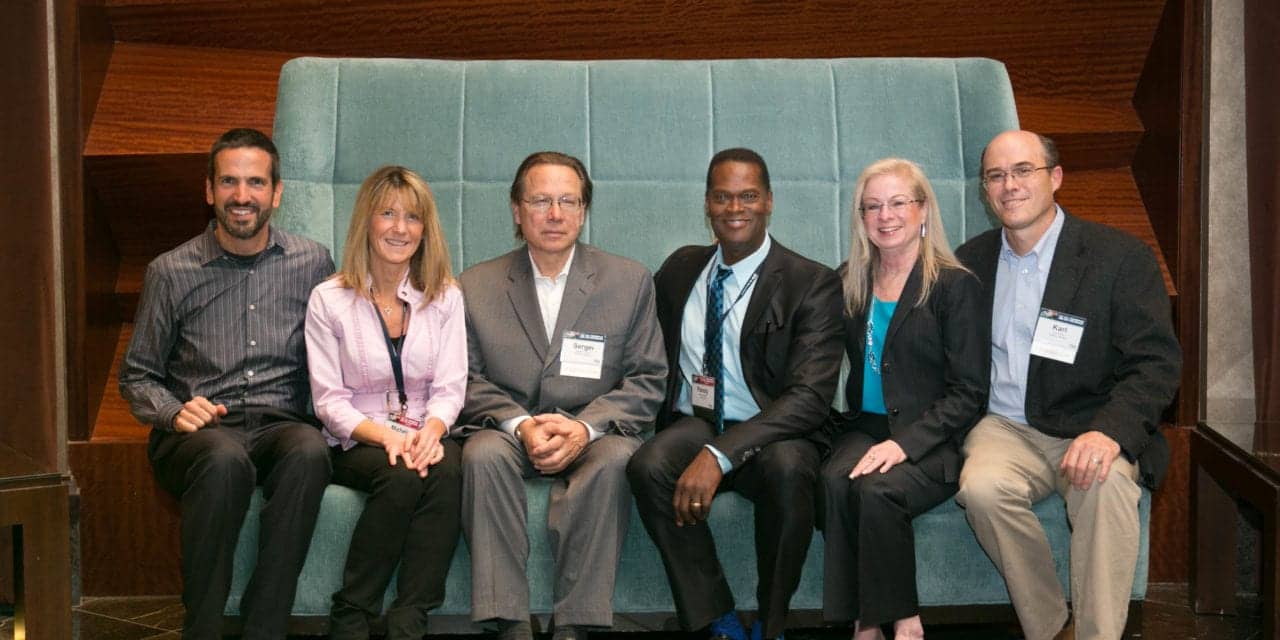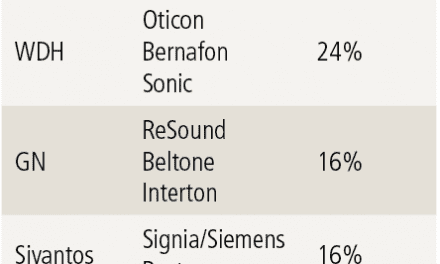![[Click on images to enlarge.] From l to r: Alex Aubert, Solutionreach; Michele Ahlman, Clear Digital Media/HNN; Sergei Kochkin, PhD, industry consultant; Randall Baldwin, CareCredit; Dana Fisher and Karl Strom, The Hearing Review.](https://hearingreview.com/wp-content/uploads/2014/11/22_GroupPhoto2-149-3685637336-O-300x200.jpg)
[Click on images to enlarge.] From l to r: Alex Obbard, Solutionreach; Michele Ahlman, Clear Digital Media/HNN; Sergei Kochkin, PhD, industry consultant; Randall Baldwin, CareCredit; Dana Fisher and Karl Strom, The Hearing Review.
The seminar included three speakers that included Dr Kochkin on the key factors related to patient loyalty and the consequences having loyal (or disloyal) customers, as well as Alex Obbard and Michele Ahlman who showed two examples of relatively new technologies that can be used to increase customer loyalty in a modern hearing healthcare practice.
Dr Kochkin’s 10 Tips for Patient Loyalty. Introduced by CareCredit Director of Provider Marketing Randy Baldwin, Dr Kochkin reviewed some facts about the hearing healthcare market, noting:
- A 2.6% compound annual growth (CAGR) rate for the private (non-VA) hearing aid market;
- 63.4% of customers are repeat purchasers;
- The average new-user age is about 70;
- Binaural hearing aid use, which has been a significant driver in hearing aid sales during the past two decades, is approaching a saturation level;
- Hearing aid brand loyalty has never exceeded 50%;
- The vast majority of hearing care practices lack a method for obtaining feedback about their customers’ satisfaction with their products and services;
- 20% of non-adopters are hesitant to get hearing help because of negative reports from friends or relatives;
- There are about 1 million customers who have what might be called “in the drawer” hearing aids.
In view of the above, Kochkin says our current customers are the key to any future success for both hearing care professionals and the hearing industry. Similarly, in an era when Big Box and Internet sales are threatening the bottom lines of hearing care practices, it has become vital to have a laser-like focus on the outcomes, satisfaction, and value propositions for current customers who represent the key drivers of industry profitability and growth via new referrals.
Kochkin reviewed many of the central ideas from Deming’s book, Out of Crisis, and Heskett’s classic Harvard Business Review article, noting that the most successful businesses do everything possible to create apostles—customers who are not just satisfied with what is offered but who actively promote a business’s products and services to friends and relatives. Likewise, it’s also important to minimize those “just satisfied” patients who have a high chance (particularly as shown in hearing care market surveys) of defecting to a competitor, or worse, the saboteurs who have had a poor experience and are hell-bent to tell everyone they should avoid your business. Lower levels of customer satisfaction translate into fewer sales and referrals, more return for credits, more bad debt write-offs, lower staff morale and absenteeism, poor compliance with instructions, and lower profitability. (For more details, see Dr Kochkin’s article, “What is Your Customer Loyalty Quotient (CLQ)?”, in the September 2014 edition of The Hearing Review.)
Dr Kochkin, based on 25 years of market research in hearing healthcare, proposed these 10 patient loyalty tips for creating higher levels of customer satisfaction and benefit, and thus creating more apostles while avoiding the creation of saboteurs in a practice:
- Use best practices: Using the most comprehensive hearing healthcare protocol as an established process in your practice is the #1 way to ensure excellent patient outcomes, while avoiding commoditization, technology and distribution channel disruption, and obsolescence. All the major hearing care professional organizations have published these recommended protocols.
- Use verification and validation (V+V). The use of verification (objectively ensuring that the hearing aid delivers the correct sound level at the tympanic membrane) and validation (getting a subjective response from the patient about how they feel about your services) during the hearing aid fitting process has been proven to significantly reduce patient visits (1.2 fewer visits) and profoundly influence customer satisfaction.
- Quality assurance. Test in a sound booth, verify that the hearing aid is working correctly via a test box, ensure that loud sounds are comfortably loud, and that the hearing aid earmold is not painful.
- Really talk with your customers. Make it easy for them to give you feedback, establish a system for routine customer outgoing audits, and use subjective and objective benefit measures to improve your practice.
- Offer a money-back guarantee. In market surveys, this was the #1 desired hearing aid feature by non-adopters of hearing aids. A 90-day trial finished #14 for all potential hearing aid users.
- Provide excellent MELU. Multiple environmental listening utility (MELU)—the ability to listen in the widest possible variety of everyday settings—is intimately related to customer loyalty. According to Kochkin, apostles can only be created by providing excellent near- and far-field hearing aid utility.
- Understand cost/affordability issues and do something about it. Issues related to cost account for 4 of the top-10 most important factors for non-adoption of hearing aids, according to market studies. Offering a range of prices and financing options provides a solution to this significant barrier in hearing aid adoption.
- Counsel patients. Education should begin before the first visit and continue throughout the patient’s involvement with the practice. Counseling includes aural rehabilitation and instruction about hearing strategies, assistive devices, consumer groups, along with the standard device orientation.
- Overall office quality. The overall appearance of the dispensing practice, including the waiting room, has been shown to have a significant influence on overall customer satisfaction.
- Re-define your success. The success of a practice should not necessarily be tied to hearing aids sales, but rather objective and subjective quality measures of hearing aid benefit. Success should be re-defined as the number of apostles generated by a practice.
Using the waiting room to enhance patient education and customer satisfaction. Kochkin then introduced Michele Ahlman, CEO of Clear Digital Media, a company that has created the Hearing News Network (HNN), a digital signage platform designed to speak directly to patients sitting in waiting rooms. HNN is a constantly changing video stream—customizable to suit a practice’s education, marketing, or branding initiatives—delivered via a wired or wireless Internet connection to your waiting-room TV. Ahlman’s presentation focused on how one can use HNN as part of a strategy to create inviting waiting room spaces that precondition and prep the patient, while instilling a sense of confidence that he/she has made the right decision to make an appointment and visit your office. She says that engaging your customers in the waiting room sets the tone for a successful appointment and helps create the groundwork for a lasting relationship.
The delivery of dynamic content within the waiting room experience can be a key part of the patient’s experience, says Ahlman, during a period that otherwise can be fraught with boredom and anxiety. Dynamic video content engages patients’ brains, educates and preconditions them for the appointment, reinforces their understanding of the consequences of untreated hearing loss, and inspires and motivates them to take positive action.
A patient management system for increased patient engagement. Kochkin then introduced Alex Obbard of Solutionreach, a provider-led, cloud-based platform designed to enhance patient relationships and optimize the patient experience though a variety of contact points, including phone, text, and email messaging. The ultimate goal of Solutionreach, says Obbard, is to help practices enhance the effectiveness of their communications with patients, thus retaining and educating current patients, reactivating previous patients and tried-but-not-sold patients, as well as acquiring new patients.
Solutionreach started out as a company offering a basic (and, at the time, high-tech) appointment-reminder service, that texted and/or emailed a patient with information about their upcoming office visit. It has since evolved into a comprehensive patient management platform that is currently being utilized by over 40,000 practice owners in a diverse range of disciplines, from dentistry to vision care centers. Just a few of the system’s capabilities include:
- Rescheduling and same-day messaging. A feature that contacts patients who have requested an immediate appointment when an unexpected opening occurs due to an appointment cancellation. This function allows the first person responding to fill the place of the cancellation.
- Reactivating patients. An electronic recare/recall feature automatically messages patients when they are due for their continuing care date, and can also be customized to message patients who have been out of contact with the practice.
- Patient questionnaires and feedback. The system can be set up to query patients about how they felt about their experience during their visit via email or in-office tablet surveys.
- Birthday greetings, promotions, and patient education. Solutionreach also has a unique birthday greeting function and can be also be used for seasonal and product/service promotions. The system is capable of distributing electronic enewsletters, as well as marketing and educational materials that target specific client groups.
- Social media and monitoring. The system can encourage patients to chime in about your services online, and also helps monitor and manage your practice’s online reputation.
A question and answer session, as well as a wine and hors d’oeuves reception, followed the seminar that included extended discussions with attendees about topics related to the presentation.
Look for The Hearing Review‘s 3-part video series that features this event in the near future on our website.









